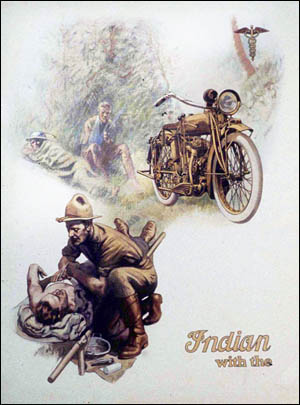Parece ser que es una Indian y no una Harley, pero la voluntad es lo que cuenta.
No soy un Motero, pero los coleccionistas serios de estas maquinas saben que una Indian Original es mil veces mas valiosa que cualquier Harley.



This is the motorcycle that helped the U.S. win the First World War.
Unfortunately, it’s also a bike that set Indian back significantly in its battle with Harley-Davidson. But then, that’s the kind of story that’s common in Indian’s history: “two steps forward, one step back.”
You certainly can’t blame the motorcycle itself. The military model was closely based on Indian’s famed Powerplus Big Twin, which had, according to sales literature, the “most powerful and economical engine ever fitted to a motorcycle.’’
Hyperbole aside, this 61-cubic-inch (1,000cc) engine was a significant improvement over the previous generation F-head motor. Pumping out 18 horsepower, it could propel the machine to 60 mph and remain reliable. It was a package good enough for the legendary Cannonball Baker, who used Powerplus machines to set many of his endurance records for the Indian factory.
Military versions of the bike, like this one owned by David Uhl and now on display in the Motorcycle Hall of Fame Museum at AMA headquarters in Pickerington, Ohio, shared the same three-speed transmission, rear-only brake and leaf-spring front fork as the civilian model. But they also sported rear suspension, a simpler gas headlight instead of electric and functional flat fenders instead of curved versions.
The Army loved the bike so much it bought nearly 50,000 of them during the war years. As a result, Indian devoted virtually its entire production to the war effort from 1917 through 1919. In hindsight, Indian didn’t realize the damage such a strategy would inflict on its civilian dealers, who were left with almost no motorcycles to sell.
In contrast, Harley built about 20,000 military bikes during WWI—while keeping a small stream of machines flowing to dealers. With products to sell, Harley dealers fared better than their Indian counterparts in the lean years. And when the war ended, Harley-Davidson was able to go right back to selling motorcycles to civilians.
Meanwhile, with only a remnant of its once-dominant dealer network, Indian was forced to spend time and effort re-establishing its place in the market—and lost serious ground. Indian would rebuild and continue for another three decades, but the company never regained its leading position.
In the end, Indian won the war, but lost the battle.
sin duda para mi la moto mas emblemática de esa época, puedo estar equivocado que opinan los fanáticos moteros del foro? ( que se que los hay)





















 :
:


 y, para mi, la pistola.
y, para mi, la pistola. 

